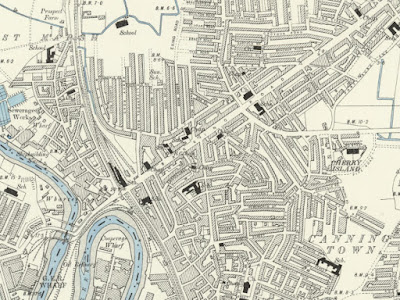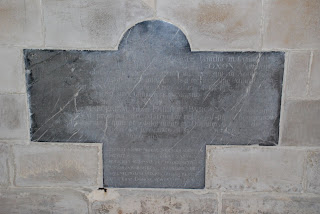 |
| Proceedings of the Central Criminal Court, 9 Jan 1899 |
In the summer of 1883, Sarah Jane Pittaway (1859-1932), a sister of my gg-grandfather Joseph Snow Pittaway (1852-1927), married Julian Haverfield Rowland in the Camberwell district of South London. Like many young women from Watchet, Somerset, Sarah Jane had gone into service in London. In 1881 she was a housemaid in the home of Richard Cross, a draper in Deptford. At the time of her marriage Sarah was with child, as her daughter Maud was also born in the summer of 1883.
Julian Haverfield Rowland, the son of James Rowland and Ann, was born in 1844 in Deptford, however, the family moved to Gloucestershire before 1851. Julian was baptised at Cromhall, Gloucestershire on 1 Jan 1851, and was living in that parish at the time of the 1851 Census. By the 1861 Census the family had moved to Wooton under Edge, Gloucestershire.
Julian then disappears from the record until his marriage to Sarah Jane Pittaway. Their daughter Lillie May was born in the spring of 1885, and their daughter Florence Ada was born a year later. Both births were registered in the Woolwich district of London.
The family appears in the 1891 Census living at 51 Barking Road, West Ham, Essex. Julian, however, has been replaced by Joseph E. Nugent, a general practitioner. Sarah Jane and her three children are recorded as having the surname Nugent. Did Julian die and Sarah Jane remarry? The answer is no. Until he was convicted for manslaughter and perjury in 1899, Julian Haverfield Rowland had for several years impersonated Dr. Edward Joseph Nugent.
 |
| Kelly's 1887 Directory |
 |
| Barking Road, West Ham, Essex |
A police investigation revealed that Julian was not Edward Joseph Nugent. As a result he was further charged with committing perjury at the coroner's inquest.
One of the witnesses at Julian's magistrates' court appearance was Armanda Nugent, the wife of the real Edward Joseph Nugent. She testified that her husband had left England for Australia in 1895, that he had given his medical diplomas to Julian, and that Julian, who she knew as John Rowland, paid her 3s 6d a week. Other witnesses confirmed that Julian was not Nugent. Dr. Carey testified that he had known Julian as Dr. Nugent for eight years. The case was sent to trial and Julian was released on £300 bail.
 |
| John Charles Darling |
The case was widely covered in British newspapers and generated articles in both the Lancet and the British Medical Journal. Articles also appeared in newspapers in New South Wales and New Zealand.
But who was Edward Joseph Nugent? Edward, the son of James Nugent and Anna Marie O'Donahue was born in Ireland about 1850. In 1866 he became a licentiate of the Royal College of Surgeons in Ireland, and in 1872, a licentiate of the King and Queen's College of Physicians in Ireland. In 1884 he married a cousin, Armanda Nugent, in Dublin. Two children were born in Ireland. About 1889 he brought his family to London where his son Joseph Ignatius was born in the winter of 1890. At the time of the 1891 Census, Edward was living with his family in Deptford.
Edward fell into financial difficulty and departed London on the SS Aberdeen for Sydney, Australia on 16 Jan 1895 leaving his wife and children behind. He was certified as a medical practitioner in New South Wales later than year. Armanda and her children joined him in Australia about 1900.
In Apr 1906, Edward was admitted to the Liverpool Asylum for the Infirm and Destitute. He was discharged in May 1907, readmitted in Mar 1909 and discharged again in June 1912. Edward Joseph Nugent died on 27 Dec 1915 and was buried in the Rookwood Catholic Cemetery in Sydney. His wife, Armanda, died on 19 Aug 1939 and was also buried at Rookwood.
 And what of Julian Haverfield Rowland? At the time of the 1901 Census, Julian was in Parkhurst prison. Sarah Jane was still living in West Ham with her daughters. In directories from 1902 onwards Julian is listed as an artificial teeth manufacturer, although his daughter Lillie May describes him as a dentist on her 1907 marriage certificate. In 1911 Julian, now a "mechanical dentist" and Sarah Jane were living in Willesden, Middlesex with two of their grandchildren. Julian Haverfield Rowland died in 1913. Sarah Jane returned to Watchet where she died in 1932.
And what of Julian Haverfield Rowland? At the time of the 1901 Census, Julian was in Parkhurst prison. Sarah Jane was still living in West Ham with her daughters. In directories from 1902 onwards Julian is listed as an artificial teeth manufacturer, although his daughter Lillie May describes him as a dentist on her 1907 marriage certificate. In 1911 Julian, now a "mechanical dentist" and Sarah Jane were living in Willesden, Middlesex with two of their grandchildren. Julian Haverfield Rowland died in 1913. Sarah Jane returned to Watchet where she died in 1932.























